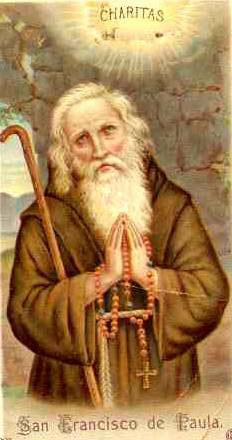St. John of Beverley
FREE Catholic Classes
Bishop of Hexham and afterwards of York; b. at Harpham, in the East Riding of Yorkshire; d. at Beverley, 7 May, 721. In early life lie was under the care of Archbishop Theodore , at Canterbury, who supervised his education, and is reputed to have given him the name of John. He became a member of the Benedictine Order, and for a time was an inmate of St. Hilda's monastery at Streaneshaleh (Whitby). Afterwards he won renown as a preacher, displayed marked erudition in expounding Scripture, and taught amongst other subjects. On 25 August, 687 was consecrated Bishop of Hexham, a district with which he was not unfamiliar, as he had for a period led a life of retreat at Erneshowe (Herneshou), on the opposite bank of the Tyne. Here, too, he was afterwards wont to resort for seclusion, especially during Lent, when the cares of his episcopal ministration permitted of his so doing. John was present at the synod on the Nidd in 705, convened by Osred, King Of Northumbria, to decide on Wilfrid's case. In the same year (703), on the death of Bosa, John was translated to York after eighteen years of labour in the See of Hexham, where he was succeeded by Wilfrid. Of his new activity little is known beyond that he was diligent in visitation, considerate towards the poor, and exceedingly attentive to the training of students whom he maintained under his personal charge. His little company of pupils is said to have included: Bede, whom he ordained ; Berethume, afterwards Abbot of Beverley ; Herebald, Abbot of Tynemouth ; and Wilfrid "the Younger", John's successor (718) in the See of York. Having purchased a place called Inderawood, to which a later age has given the name of Beverley, John established a monastery there and also handsomely endowed the place, which became even in its founder's day an important ecclesiastical centre. To this monastery of Beverley, after resigning the See of York to his pupil Wilfrid, John retired and spent the remainder of his life with Abbot Berethune, a one time favourite scholar. In 1037 he was canonized by Benedict IX ; His bones were translated by Ælfric, Archbishop of York, and placed in a costly shrine. A second translation took place in 1197. The remains were discovered in 1664 and again brought to light in 1736. (See BEVERLEY MINSTER.)
Join the Movement
When you sign up below, you don't just join an email list - you're joining an entire movement for Free world class Catholic education.

-

- Stations of the Cross
- Easter / Lent
- 5 Lenten Prayers
- Ash Wednesday
- Living Lent
- 7 Morning Prayers
- Mysteries of the Rosary
- Litany of the Bl. Virgin Mary
- Popular Saints
- Popular Prayers
- Female Saints
- Saint Feast Days by Month
- Pray the Rosary
Pope Francis’ April Prayer Intention: Using Technology to Strengthen Human Connections
Finding Peace Through Prayer in a World of Worry
Trump Administration Withholds Federal Grants from Planned Parenthood Over DEI and Civil Rights Concerns
Daily Catholic
 Daily Readings for Wednesday, April 02, 2025
Daily Readings for Wednesday, April 02, 2025 St. Francis of Paola: Saint of the Day for Wednesday, April 02, 2025
St. Francis of Paola: Saint of the Day for Wednesday, April 02, 2025 Prayer for God's Help in Daily Actions: Prayer of the Day for Friday, March 14, 2025
Prayer for God's Help in Daily Actions: Prayer of the Day for Friday, March 14, 2025 Daily Readings for Tuesday, April 01, 2025
Daily Readings for Tuesday, April 01, 2025 St. Hugh of Grenoble: Saint of the Day for Tuesday, April 01, 2025
St. Hugh of Grenoble: Saint of the Day for Tuesday, April 01, 2025- To Perceive Animals as God's Gifts: Prayer of the Day for Thursday, March 13, 2025
![]()
Copyright 2025 Catholic Online. All materials contained on this site, whether written, audible or visual are the exclusive property of Catholic Online and are protected under U.S. and International copyright laws, © Copyright 2025 Catholic Online. Any unauthorized use, without prior written consent of Catholic Online is strictly forbidden and prohibited.
Catholic Online is a Project of Your Catholic Voice Foundation, a Not-for-Profit Corporation. Your Catholic Voice Foundation has been granted a recognition of tax exemption under Section 501(c)(3) of the Internal Revenue Code. Federal Tax Identification Number: 81-0596847. Your gift is tax-deductible as allowed by law.


 Daily Readings for Wednesday, April 02, 2025
Daily Readings for Wednesday, April 02, 2025 St. Francis of Paola: Saint of the Day for Wednesday, April 02, 2025
St. Francis of Paola: Saint of the Day for Wednesday, April 02, 2025 Prayer for God's Help in Daily Actions: Prayer of the Day for Friday, March 14, 2025
Prayer for God's Help in Daily Actions: Prayer of the Day for Friday, March 14, 2025 St. Hugh of Grenoble: Saint of the Day for Tuesday, April 01, 2025
St. Hugh of Grenoble: Saint of the Day for Tuesday, April 01, 2025

